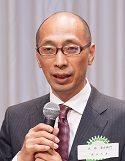The Beauty of Kama and its Creation
14 June, 2017
Mr. Seiemon Ohnishi
The 16th Generation Kama-shi of the Senke Jisshoku
�� I create kama (iron tea kettle) for Japanese tea ceremony in the heart of Kyoto City. I am the 16th generation head of the Onishi family and my foundry workshop is behind the Onishi Seiwemon Museum where various tea utensils are exhibited. The history of my family dates back to the Edo era when Onishi Jorin started to live in the area known as kamanza, meaning a guild of ironsmiths. Our family created kama for samurai lords as well as Buddhist temple bells. Among different tea ceremony utensils, kama has the widest variety of shapes and designs, despite its complicated creation procedures that require craftsmanship and expertise. It is because the feudal lords who enjoyed tea ceremony asked their craftsmen to create the one and only kama that reflected their personality and identity.
I create kama (iron tea kettle) for Japanese tea ceremony in the heart of Kyoto City. I am the 16th generation head of the Onishi family and my foundry workshop is behind the Onishi Seiwemon Museum where various tea utensils are exhibited. The history of my family dates back to the Edo era when Onishi Jorin started to live in the area known as kamanza, meaning a guild of ironsmiths. Our family created kama for samurai lords as well as Buddhist temple bells. Among different tea ceremony utensils, kama has the widest variety of shapes and designs, despite its complicated creation procedures that require craftsmanship and expertise. It is because the feudal lords who enjoyed tea ceremony asked their craftsmen to create the one and only kama that reflected their personality and identity.
��Today at Hosenji Temple in Shinagawa, we find a bell produced by Onishi Josei II who was known as the greatest artisan of the family��s heritage. The bell was once brought to Europe around the 1870s to be exhibited at the Universal Exhibition. Mysteriously enough, it disappeared and the chief priest of Hosenji Temple had to travel around the world searching for it until it was finally found at the Ariana Museum in Geneva, Switzerland, in the 1910s. The bell was returned from Geneva to Shinagawa, which marked the beginning of a special friendship between the two cities.
��The creation of kama starts with designing its shape, creating the inner and outer molds based on the design and pouring heated iron that exceeds 1300�� in between the two molds. Kasa-gama (Shigure) was created by the first Onishi Jorin. You find its surface has a patchy pattern as the kama was re-heated for oxide coating to strengthen the iron and protect it from deformation. It was a new technique introduced about 400 years ago to create Kyo-gama. Yagaku Kama was originally created by Onishi Josei II and is owned by Ginkakuji Temple. As you can see, Josei applied a unique technique to create this complicated shape. I attempted its re-creation in my 20s and finally succeeded after spending 20 years. I enjoy experimenting with new creations modeled on famous works and methods from the past.
��I also strive to get ahead of my forefathers. Arare Kama (hailstone-patterned kettle) was originally created by the first Onishi Jorin. The bottom of the kama got thinner over several hundred years due to thermal fatigue and my predecessors have restored it many times. I created this Arare Odaregama by covering the original Arare Kama over a slightly smaller kama and gluing them together with a special adhesive material made of lacquer and iron powder. I try to be creative so that even decayed kama can rekindle its flavor to be cherished for many more years to come. Japanese people find beauty in rustic, imperfect or even decayed works as they symbolize the impermanence of all things.
��When my father Onishi Jyoshin XV fell ill, I was in my 20s. I was at a loss because there was still much to learn from him, especially about the works done by my forefathers during the Edo period. I decided to take a closer look at their works and tried to identify what kind of techniques they had applied. I have tried to recreate the old techniques and learned from any failures.
��I receive different requests from my clients. For example, I was requested by a temple to create a kama using the iron hinge and decorative piece reclaimed from the gate of Fushimi Castle built over 400 years ago. I hesitated to melt the iron because it would turn into something new. I decided to create a new kama and then to attach the hinge and decorative piece so that they would continue to be in use over the next few hundred years. Another client hosted an interesting tea ceremony themed on traditional African masks. I created a kama with a hemp line to best match the taste of my client with the occasion. Among different tea utensils, it takes the longest to create kama as it goes through multiple procedures. That is why I made it a policy to find my clients and to create original kama that best meets their taste and request from my 30s. I have been fortunate enough to meet good clients and be given a chance to create a wide variety of kama.
��I am determined to keep working to recreate the old techniques as well as create custom-made kama.